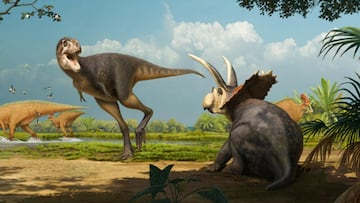Forget Rex, a new type of Tyrannosaurus has been discovered
Some bones forgotten in a drawer for more than 20 years turned out to be from a species of dinosaur never seen before.

After 24 years in a drawer at the Desert Museum in the Mexican city of Saltillo, a group of local paleontologists has established that the bones belong to a species nicknamed Labocania aguillonae, a predatory dinosaur, a close relative of Tyrannosaurus rex, that lived more than 70 million years ago in what is now the Mexican state of Coahuila de Zaragoza, during the Cretaceous period.
These bones were discovered in the year 2000 by paleontologist Martha Carolina Aguillón and corresponded to the jaw and skull of the specimen. The fossils were found in Cerro del Pueblo, a site near the city of Saltillo famous for the many discoveries made there and one of the places that has the most evidence of dinosaurs in all of Mexico.
These bones were forgotten and stored in the city museum. More than two decades later, a team led by researcher Héctor Rivera and paleontologist Nick Longrich, from the University of Bath in England, have demonstrated the existence of a species of tyrannosaurus that lived in southern North America.
El Museo del Desierto presentó una nueva especie de tiranosaurio encontrado en el sureste de Coahuila, el cual fue nombrado Abocania aguillonae en honor a su descubridora, la paleontóloga Martha Carolina Aguillón. pic.twitter.com/LfWnhXhdTW
— EL NORTE (@elnorte) September 25, 2024
“Labocania aguillonae”: a new type of Tyrannosaurus has been discovered
It is named after the first person to discover the remains of this dinosaur, the paleontologist Martha Aguillón. This is a very important discovery for Mexico, as it proves the theory that there was a tribe of tyrannosaurs, or close relatives, inhabiting the territories that are now part of Mexico.
Related stories
In the 1970s, one of these species was discovered in Baja California, but it was not enough to confirm that species similar to the mythical tyrannosaur had settled in Mexico during the Cretaceous.
According to researchers, this Labocania aguillonae was about ten metres long and had long legs that allowed it to reach great speed. However, according to research published in the journal MDPI Fossil Studies, this specimen was somewhat lighter than its famous relative, but had larger eyes that presumably allowed it to hunt in low light, as well as a heavier snout.


Complete your personal details to comment